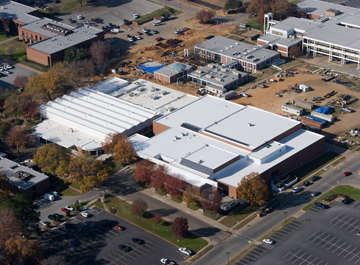The official colors of Tyler Junior College in Tyler, Texas, might be black and athletic gold, but when it comes to campus building roofs, the school prefers to see “white and green.” White, for the color of the Sika Sarnafil EnergySmart Roof® membrane, and “green” for the roof’s energy savings and environmental benefits.
“Tyler Junior College is one of the largest junior colleges in the nation, and our new college president, Dr. L. Michael Metke, wanted to make the campus ‘greener’ and shrink our ecological footprint,” explained Kevin Jones, assistant director of Facilities and Construction at Tyler Junior College. “So when we looked to replace some of the failing roofs at the college, we wanted to find a roofing system that was sustainable and good for the environment.”
Jones did some research on the Internet and found one product that would meet this criterion was the Sika Sarnafil roofing system. Unlike the dark-colored modified bitumen, ballasted EPDM, and BUR roofs previously installed on the college buildings, the EnergySmart Roof reflects 83% of the sun’s rays, thereby keeping the building cooler and reducing air conditioning costs. With an emissivity rating of 90%, the small amount of heat that is not reflected is quickly released back to the atmosphere.
“Our administration also liked the fact that the Sika Sarnafil roofing membranes can be recycled at the end of their useful lives,” Jones said. In fact, Sika Sarnafil recently became the first roofing manufacturer to receive UL recycled content certification.
Although Jones was impressed with the environmental benefits of the Sika Sarnafil membrane, he wanted to be sure that the roofing system would also perform well.
“I read that the Sika Sarnafil membrane was used on the new Dallas Cowboys stadium, so I contacted a Sika Sarnafil representative to learn more,” Jones said. “Not only did he give me a tour of the Cowboys stadium but he also showed me a 30-year-old Sika Sarnafil roof at a Southwest Foods warehouse and manufacturing facility here in Tyler — and that roof looked like it was only 10 years old. That’s when we decided to go with the Sika Sarnafil system.”
The Vaughn Library received the first Sika Sarnafil roof at the junior college in 2010, and the Wagstaff Gym was next. The school has been very pleased with their experience with Sika Sarnafil. Subsequently, Sarnafil® roofs were chosen for the campus Information Technology Building, the Genecov Science Building, and for the college’s Hudnall Planetarium.
“We wanted a roofing system that wouldn’t need any attention for a long time, and to date we have never had a single call or issue with any of the Sika Sarnafil roofs,” Jones said. “In fact, our goal is to install Sika Sarnafil roofing systems on all of our flat roofs.”
He added, “Sometimes following a green initiative is not economically feasible, but that’s not the case with the Sika Sarnafil roofs. They have a durable, long-lasting, energy efficient product backed up by a worldwide company.” BD+C
Related Stories
Office Buildings | Oct 16, 2023
The impact of office-to-residential conversion on downtown areas
Gensler's Duanne Render looks at the incentives that could bring more office-to-residential conversions to life.
Giants 400 | Oct 11, 2023
Top 100 Industrial Sector Architecture Firms for 2023
Ware Malcomb, Arcadis, Stantec, and Gresham Smith top the ranking of the nation's largest industrial facility sector architecture and architecture/engineering (AE) firms for 2023, as reported in Building Design+Construction's 2023 Giants 400 Report.
Products and Materials | Oct 10, 2023
‘Works with WELL’ product licensing program launched by International WELL Building Institute
The International WELL Building Institute (IWBI) recently launched the Works with WELL product licensing program. Works with Well certification allows manufacturers to demonstrate that their products align with WELL strategies.
Mass Timber | Oct 10, 2023
New York City launches Mass Timber Studio to spur more wood construction
New York City Economic Development Corporation (NYCEDC) recently launched New York City Mass Timber Studio, “a technical assistance program to support active mass timber development projects in the early phases of project planning and design.”
Government Buildings | Oct 10, 2023
GSA names Elliot Doomes Public Buildings Service Commissioner
The U.S. General Services Administration (GSA) announced that the agency’s Public Buildings Service Commissioner Nina Albert will depart on Oct. 13 and that Elliot Doomes will succeed her.
Esports Arenas | Oct 10, 2023
Modular esports arena attracts more than gamers
As the esports market continues to grow to unprecedented numbers, more facilities are being developed by universities and real estate firms each year.
Higher Education | Oct 10, 2023
Tracking the carbon footprint of higher education campuses in the era of online learning
With more effective use of their facilities, streamlining of administration, and thoughtful adoption of high-quality online learning, colleges and universities can raise enrollment by at least 30%, reducing their carbon footprint per student by 11% and lowering their cost per student by 15% with the same level of instruction and better student support.
MFPRO+ News | Oct 6, 2023
Announcing MultifamilyPro+
BD+C has served the multifamily design and construction sector for more than 60 years, and now we're introducing a central hub within BDCnetwork.com for all things multifamily.
Giants 400 | Oct 5, 2023
Top 175 Healthcare Architecture Firms for 2023
HDR, HKS, CannonDesign, Stantec, and SmithGroup top BD+C's ranking of the nation's largest healthcare sector architecture and architecture/engineering (AE) firms for 2023, as reported in Building Design+Construction's 2023 Giants 400 Report. Note: This ranking includes revenue related to all healthcare buildings work, including hospitals, medical office buildings, and outpatient facilities.
Biophilic Design | Oct 4, 2023
Transforming the entry experience with biophilic design
Vessel Architecture & Design's Cassandra Wallace, AIA, NCARB, explores how incorporating biophilic design elements and dynamic lighting can transform a seemingly cavernous entry space into a warm and inviting focal point.

















